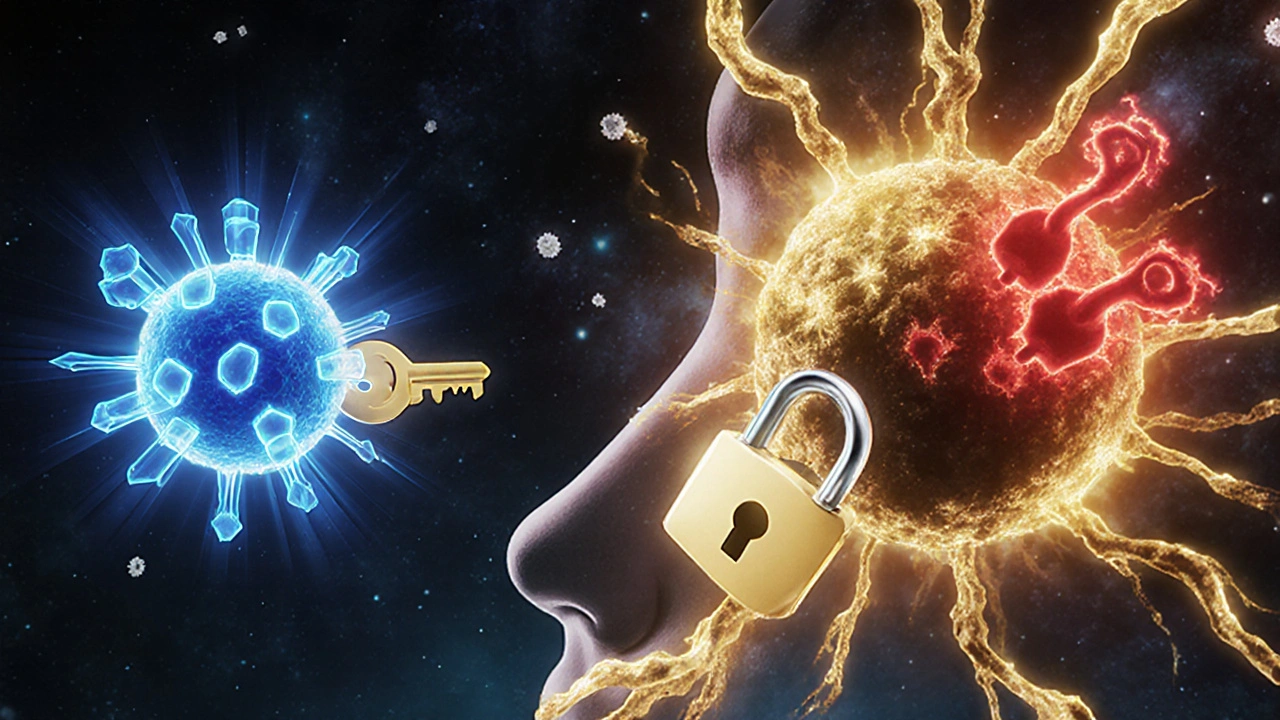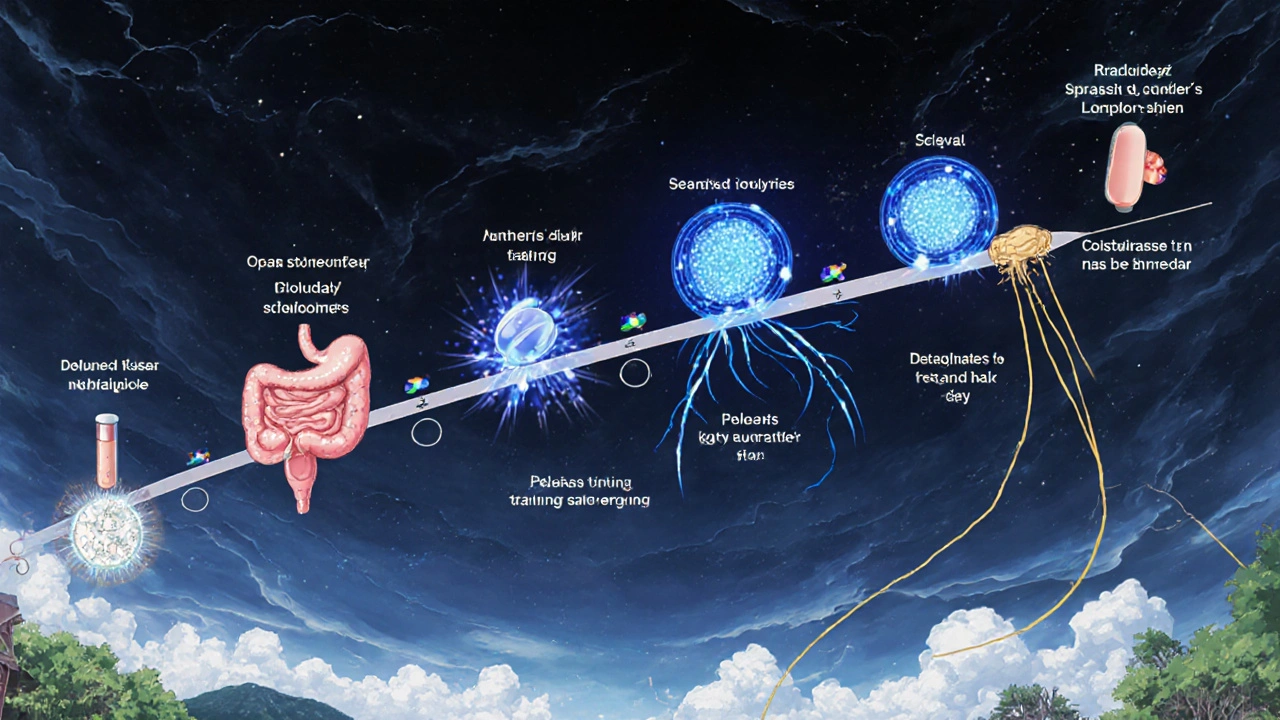How Loratadine Works: A Deep Dive into Its Mechanism of Action

Loratadine doesn’t just make your runny nose go away-it stops the root cause before it starts. If you’ve ever taken a daily allergy pill and wondered why it works without making you sleepy, the answer lies in how loratadine interacts with your body at a molecular level. Unlike older antihistamines, it doesn’t cross the blood-brain barrier easily, which is why you don’t feel drowsy. But how exactly does it block allergies in the first place? Let’s break it down step by step.
What happens during an allergic reaction?
When you breathe in pollen, dust, or pet dander, your immune system mistakes it for a threat. In response, specialized cells called mast cells release a chemical called histamine. Histamine is the main trigger for allergy symptoms: it makes blood vessels leak fluid into tissues (causing swelling), tightens airway muscles (leading to wheezing), and stimulates nerve endings (making you itch or sneeze). This is why your eyes water, your nose runs, and your skin gets red and itchy.
Before loratadine came along, people relied on drugs like diphenhydramine (Benadryl) or chlorpheniramine. These worked well but made most users feel like they’d had a few too many drinks-drowsy, foggy, and sluggish. That’s because they crossed into the brain and blocked histamine receptors there. Histamine isn’t just an allergy chemical; it also helps keep you awake and alert. So blocking it in the brain = sleepiness.
How loratadine is different
Loratadine was developed in the late 1980s and approved by the FDA in 1993. It was one of the first second-generation antihistamines designed to avoid the brain. Its chemical structure is bulkier and more polar than older antihistamines, which makes it harder to pass through the blood-brain barrier. That’s the key difference: it blocks histamine where it matters-outside the brain.
Inside your body, loratadine binds tightly to H1 receptors. These are the specific protein sites on cells that histamine normally attaches to. Think of histamine as a key and the H1 receptor as a lock. When histamine turns the lock, it triggers inflammation and allergy symptoms. Loratadine is like a fake key that fits perfectly into the lock-but it doesn’t turn it. It just sits there, blocking the real key (histamine) from getting in.
This blocking effect lasts a long time. Loratadine has a half-life of about 8 hours in adults, but its active metabolite, desloratadine, sticks around for up to 27 hours. That’s why one pill a day is enough for most people. The drug doesn’t just act quickly-it lasts.
Where loratadine works in the body
Loratadine doesn’t just float around randomly. It concentrates in the tissues where allergies happen most: the nose, eyes, lungs, and skin. Studies using radioactive tracers show that after taking a 10 mg dose, loratadine builds up in the nasal mucosa within 2 hours and stays there for over 24 hours. That’s why it’s so effective for allergic rhinitis-hay fever, dust allergies, seasonal stuff.
It also reduces the number of inflammatory cells that show up after exposure to allergens. In one clinical trial, people taking loratadine had 40% fewer eosinophils (a type of white blood cell involved in allergic inflammation) in their nasal secretions compared to those on placebo. That’s not just symptom relief-it’s actually calming the immune system’s overreaction.

Why it doesn’t make you sleepy
Let’s go back to the brain. Histamine in the brain helps regulate wakefulness. The hypothalamus uses histamine to keep you alert during the day. Older antihistamines like diphenhydramine easily slip into the brain and shut down this system. Loratadine? Not so much.
Research using PET scans shows that even at high doses, loratadine barely registers in the brain. One study from 2001 gave participants 10 mg of loratadine and measured brain histamine receptor occupancy. Results? Less than 10% occupancy. Compare that to diphenhydramine, which blocks over 70% of brain H1 receptors. That’s why you can drive, work, or study after taking loratadine without feeling impaired.
It’s not just about being non-sedating-it’s about precision. Loratadine targets the problem without disrupting your central nervous system.
How fast does it work?
Loratadine starts working within 1 to 3 hours after you take it. Peak effect hits around 8 to 12 hours, and it lasts 24 hours. That’s longer than most other antihistamines. For example, cetirizine (Zyrtec) peaks faster-within 1 hour-but its duration is similar. Fexofenadine (Allegra) works just as well but can be affected by food. Loratadine? You can take it with or without meals.
For seasonal allergies, many people start taking it before pollen season begins. It doesn’t prevent the allergy itself, but it prevents the symptoms from flaring up. Think of it like a shield-not a cure, but a very effective one.
Who shouldn’t take it?
Loratadine is safe for most adults and children over 2 years old. But there are exceptions. People with severe liver disease may process it slower, leading to higher blood levels. In these cases, doctors might lower the dose or recommend a different medication.
It’s also not recommended for infants under 2, and pregnant women should check with their doctor, though studies show no major risks. It’s in Pregnancy Category B, meaning animal studies didn’t show harm, and human data hasn’t raised red flags.
Drug interactions are rare. Loratadine is metabolized by the liver enzyme CYP3A4. If you’re taking ketoconazole, erythromycin, or cimetidine, these can slow down loratadine breakdown. That’s usually not a problem at normal doses, but if you’re on multiple meds, talk to your pharmacist.

Real-world effectiveness
Over 30 million Americans use loratadine every year. It’s available over-the-counter in brands like Claritin, Alavert, and countless generics. Clinical trials show it reduces sneezing, itching, and runny nose by 60-70% compared to placebo. In head-to-head studies, it performs just as well as cetirizine and fexofenadine-but with fewer reports of drowsiness.
One 2023 study in the Journal of Allergy and Clinical Immunology followed 1,200 patients with seasonal allergic rhinitis over three pollen seasons. Those taking loratadine daily reported 50% fewer days with missed work or school compared to those who only took medication when symptoms appeared.
What it doesn’t do
Loratadine won’t help with asthma attacks. It won’t shrink nasal polyps. It won’t fix a sinus infection. It’s designed for allergic symptoms only. If you’re wheezing, have chest tightness, or your nose is blocked with thick mucus and pain, you might need something else-like a nasal steroid spray or decongestant.
It also doesn’t stop the immune system from reacting to allergens. It just blocks the final step-the histamine signal. That’s why some people still get mild symptoms, especially with high pollen counts. Combining loratadine with a nasal spray like fluticasone often gives better control.
Why this matters
Loratadine isn’t just another pill. It represents a shift in how we treat allergies: from brute-force suppression to targeted, safe, daily prevention. It’s a tool that lets people live normally around allergens instead of hiding from them. Millions rely on it not because it’s flashy, but because it works quietly, consistently, and without side effects.
Understanding how it works helps you use it better. Take it daily during allergy season, not just when you feel bad. Don’t expect instant miracles-it’s not a decongestant. And if you’re still struggling, talk to your pharmacist. There might be a better combo for your specific triggers.
Does loratadine cause drowsiness?
Loratadine is classified as a non-sedating antihistamine. In clinical trials, less than 10% of users reported mild drowsiness, and that’s usually at higher doses or when combined with other medications. It’s far less likely to cause sleepiness than older antihistamines like diphenhydramine or chlorpheniramine because it doesn’t cross the blood-brain barrier significantly.
How long does it take for loratadine to start working?
Loratadine typically begins to relieve symptoms within 1 to 3 hours after taking it. Maximum effect is reached around 8 to 12 hours, and it provides full 24-hour coverage with a single daily dose. This makes it ideal for daily use during allergy seasons.
Can I take loratadine every day?
Yes, loratadine is approved for daily use in adults and children over 2 years old. Many people take it year-round if they have perennial allergies (like dust mites or pet dander). Long-term studies show it’s safe for use over months or even years, with no signs of tolerance or increased side effects.
Is loratadine better than Zyrtec or Allegra?
All three-loratadine, cetirizine (Zyrtec), and fexofenadine (Allegra)-are equally effective for most allergy symptoms. Loratadine is slightly less likely to cause drowsiness than cetirizine, while fexofenadine can be affected by food (it works best on an empty stomach). Loratadine works regardless of meals and has the longest real-world track record for daily use.
What happens if I take too much loratadine?
Taking more than the recommended 10 mg daily dose can cause side effects like headache, rapid heartbeat, or dizziness. In rare cases, very high doses (over 40 mg) have led to abnormal heart rhythms. If you accidentally take too much, contact a poison control center or seek medical help. Don’t double up doses to make up for a missed one.
Can children take loratadine?
Yes, loratadine is approved for children as young as 2 years old. Dosing is based on weight: 5 mg daily for children 2-12 years under 30 kg (66 lbs), and 10 mg for those over 30 kg or older than 12. Always check with a pediatrician before giving any allergy medication to young children.
Does loratadine help with hives?
Yes, loratadine is effective for treating acute urticaria (hives). It reduces itching, redness, and swelling by blocking histamine in the skin. For chronic hives lasting more than 6 weeks, doctors may increase the dose to 20 mg daily under supervision, though this is off-label use.
Can I drink alcohol while taking loratadine?
While loratadine doesn’t cause drowsiness in most people, alcohol can amplify sedative effects. Mixing the two might make you feel more tired or lightheaded than usual. It’s safest to avoid alcohol, especially if you’re sensitive to medications or taking other drugs.
Kara Binning
November 20, 2025 AT 08:44Okay but let’s be real - this is just corporate propaganda dressed up as science. Loratadine? More like ‘Lora-why-did-I-pay-for-this’ when your eyes are still watering and your nose is running like a faucet. They told us it’s ‘non-sedating’ but I took it and felt like I was underwater. And don’t even get me started on the ‘24-hour’ claim - I needed a second dose by 3 PM. Wake up, people. Big Pharma is selling us placebo with a fancy label.
river weiss
November 22, 2025 AT 08:02Loratadine’s molecular specificity for peripheral H1 receptors, coupled with its low blood-brain barrier permeability, is a well-documented pharmacological advantage over first-generation antihistamines. Its active metabolite, desloratadine, exhibits a prolonged half-life, which contributes to sustained receptor occupancy and consistent symptom control. This is not merely ‘convenient’ - it is a paradigm shift in allergic disease management, grounded in structural pharmacology and clinical validation.
Brian Rono
November 22, 2025 AT 16:50Oh, so now we’re giving Nobel Prizes to antihistamines? Let’s not romanticize a drug that’s basically a molecular bouncer at the blood-brain barrier’s VIP club. Meanwhile, people are still sneezing through their pillows, and the ‘non-drowsy’ claim is just a polite lie whispered by pharmacists who’ve seen too many patients nod off at their desks. And don’t get me started on the ‘27-hour metabolite’ - that’s not science, that’s a marketing department’s fever dream. If it worked so perfectly, why do half the people I know still reach for Benadryl at 2 a.m.?
Zac Gray
November 23, 2025 AT 10:17Look, I get it - loratadine isn’t magic. But it’s the closest thing we’ve got to a silent, steady guardian against hay fever chaos. You don’t need to feel like a zombie to survive pollen season. I’ve been taking it daily for seven years. I drive, I teach, I play with my kids - all without needing a nap. Yeah, sometimes I still sneeze. But I’m not crying in my coffee because I’m too drowsy to function. That’s not hype. That’s just… life. And honestly? I’ll take ‘life’ over ‘sleepwalking through April’ any day.
Steve and Charlie Maidment
November 24, 2025 AT 12:40So you’re telling me this pill just sits there like a bouncer and blocks histamine? Cool. But what about the other 90% of the immune system that’s still screaming? It’s like putting a Band-Aid on a gunshot wound and calling it a cure. And the ‘long-lasting’ thing? Please. I’ve had days where I took it at 8 a.m. and by 4 p.m., I was back to blowing my nose like a foghorn. This isn’t prevention - it’s temporary damage control. And they charge $15 for this? For a chemical that doesn’t even fix the problem?
Michael Petesch
November 25, 2025 AT 03:53Given the global rise in allergic disorders, particularly in urbanized populations, the development of non-sedating antihistamines represents a critical public health advancement. The fact that loratadine can be administered without impairing cognitive function - while still achieving significant symptom reduction - makes it uniquely suited for use in educational and occupational settings. This is not merely pharmacological innovation; it is social infrastructure.
Ellen Calnan
November 26, 2025 AT 18:23I used to think allergies were just… inconvenient. Then I started taking loratadine daily. And suddenly, I could breathe. Not just my nose - my whole life. I went from hiding indoors during spring to hiking in the woods, laughing with friends, not sneezing every five seconds. It didn’t cure me. But it gave me back my freedom. And that? That’s worth more than any ‘mechanism of action’ chart. Sometimes, healing isn’t dramatic. Sometimes, it’s quiet. And sometimes, it’s just a little white pill that lets you live.
Richard Risemberg
November 28, 2025 AT 10:14Let’s not forget the real hero here: desloratadine. That metabolite is the unsung MVP. It’s like the sequel that outshines the original - longer-lasting, more stable, and still doesn’t knock you out. And the fact that it accumulates in nasal mucosa? Genius. It’s not just blocking histamine - it’s camping out where the battle’s happening. That’s precision medicine. Not magic. Not hype. Just really smart chemistry.
Andrew Montandon
November 29, 2025 AT 18:04Okay, real talk - I used to think loratadine was overhyped until I tried it after a year of Benadryl-induced zombie mode. I didn’t just feel less drowsy - I felt like myself again. And the fact that I can take it with coffee, with food, with my morning run? That’s freedom. I’m not saying it’s perfect - sometimes I still get itchy - but it’s the best tool we’ve got for daily life. And if you’re still using first-gen stuff? You’re not being ‘brave,’ you’re just being stubborn. Try it. You’ll thank yourself.
Sam Reicks
November 30, 2025 AT 11:06They say loratadine dont cross the blood brain barrier but what if that's a lie? What if they just dont want you to know that the real reason you're not sleepy is because your brain is slowly dying from chemical suppression? They use this stuff to make you docile so you dont ask questions about the food you eat or the air you breathe. You think its just allergies? Think again. This is control. And its working.
Chuck Coffer
December 1, 2025 AT 06:05Wow. A whole essay on a pill that doesn’t even work half the time. I’ve been on this for years. Still sneeze. Still cry. Still need tissues in every room. And you call this ‘precision medicine’? More like precision marketing. They took an old drug, tweaked the shape a bit, slapped ‘non-drowsy’ on the bottle, and called it science. Congrats. You just turned a placebo into a lifestyle product.
Christopher Robinson
December 2, 2025 AT 22:40As someone who’s tried all three big OTC antihistamines, I’ll say this - loratadine is the most reliable for daily use. No food interference, no drowsiness, just steady relief. I pair it with a nasal spray on bad days and it’s game over for pollen. 🌿💊
James Ó Nuanáin
December 3, 2025 AT 20:01While I appreciate the technical exposition, one must acknowledge that the British NHS has long favoured clemastine for chronic cases due to its superior mucosal penetration - a fact conspicuously omitted here. Loratadine may be American-approved, but it is not universally optimal. We in the UK have seen better outcomes with older agents in controlled environments. This is not American exceptionalism - it is selective reporting.
Nick Lesieur
December 4, 2025 AT 22:42So it blocks histamine... cool. So does my nose when I blow it. What's the difference? Also, why does this thing cost $15 when diphenhydramine is 99 cents? Did they add gold flakes or something? 😴
Angela Gutschwager
December 5, 2025 AT 12:05Works. No sleepiness. Take it daily. Done.